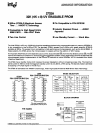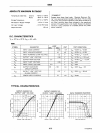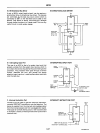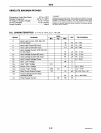
8212
FUNCTIONAL DESCRIPTION
Data Latch
The 8 flip-flops that make up the data latch are of a
"0"
type design. The output
(0)
of the flip-flop will follow the
data Input
(0)
while the clock Input (C)
Is
high. Latching
will occur when the
clock (C) returns low.
The latched data
Is
cleared by
an
asynchronous reset
Input
(CIA).
(Note: Clock (C) Overrides
Reset
(CLR).)
Output Buffer
The outputs of the data latch
(0)
are connected to 3-state,
non-Inverting output buffers. These buffers
have
a
common
control line (EN); this control line either enables
the buffer to transmit the data from the outputs of the data
latch
(0)
or disables the buffer, forcing the output Into a
high Impedance state. (3-state)
The high-impedance state allows the designer to connect
the
8212
directly onto the microprocessor bl-directional
data bus.
Control Logic
The
8212
has
control inputs
OS1,
OS2,
MO
and STB.
These inputs are
used
to control device selection, data
latching, output buffer state and service request flip-flop.
DS1, DS2 (Device Select)
These 2 inputs are
used
for device selection.
When
OS1
Is
low and
OS2
is
high
(OS1
•
OS2)
the device
is
selected.
In
the selected state the output buffer is enabled and the
service request
flip-flop
(SR)
is asynchronously
set.
MD
(Mode)
This input
is
used
to control the state of the output buffer
and to determine the source of the
clock input (C) to the
data
latch.
When
MO
is high (output mode) the output buffers are
enabled and the source of clock (C) to the data latch is
from the device
selection logic
(OS1
•
OS2).
When
MO
is
low (input mode) the output buffer state is
determined by the device
selection logic
(OS1
•
OS2)
and
the source of
clock (C) to the data latch.ls the STB
(Strobe) input.
STB (Strobe)
This input is used
as
the ciock (C) to the data latch for the
input mode
MO
=
0)
and to synchronously reset the
service request
flip-flop (SR).
Note that the
SR
flip-flop
is
negative edge triggered.
Service Request Flip-Flop
The
(SR)
flip-flop is
used
to generate and control
interrupts in microcomputer systems. It is asynchron-
ously set by the
CLR
Input (active low).
When
the
(SR)
flip-
flop is set it
Is
In
the non-Interruptl!lg state.
The output of the
(SR)
flip-flop
(0)
is connected to
an
inverting input of a "NOR" gate. The other Input to the
"NOR" gate
is
non-inverting and
Is
connected to the
device
selection logic
(OS1
•
OS2).
The output of the
"NOR" gate
(00)
Is
active low (interrupting state) for
connection to active
low Input priority generating circuits.
SERVICE
REQUEST
FF
[i>
MD
----+H~rt'
[j)
STa
-..-----i_~
\
Il> D "
--------++1
DATA
LATCH
[Z> D
'3
--------r-+1
IE>
D
'.
--------+-+1
I)]> D 's
--------++1
I)]> D
'6
--------;--+1
[lg> D
'7
--------+-+1
§>D'8-------~+1
STa
.
MO
o
(08,-0
8
21
o
3·STATE
DATA
DUTEClJAJLS
elR
(151;-0121
STa
·SR:
INT
o • • 0 , r 1
,
0
,
,
o
o
·1
o
0,
o
,
,
,
,
3·STATE
DATA
LATCH
DATA
LATCH
DATA
LATCH
.
DATA
IN
DATA
IN
DATA
IN
CLR - RESETS
DATA
LATCH
SETS
SR
FLlp·FLOP
INO
EFFECT
ON
OUTPUT
BUFFERI
8-25
o , 0 • , I 0
~
·;-·~tg
, . 0 • " I '
,
':""'\-.
1 0
-INTERNAL
SR
FLIP·
FLOP
AFN-00731
Ao02


















